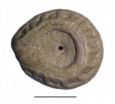(Press-News.org) To ensure the survival of Moore's law and the success of the nanoelectronics industry, alternative patterning techniques that offer advantages beyond conventional top-down patterning are aggressively being explored.
Can self-assembly based technologies offer advantages beyond conventional top-down lithography approaches?
A joint effort of the Aalto University of Helsinki, the Politecnico di Milano, and VTT Technical Research Centre of Finland has now demonstrated that it is possible to align molecular self-assemblies from nanometers to millimeters without the intervention of external stimuli.
Molecular self-assembly is a concept derived from Nature that leads to the spontaneous organization of molecules into more complex and functional supramolecular structures. The recipe is "encoded" in the chemical structure of the self-assembling molecules. Molecular self-assembly has been exploited for "templating" functional devices, molecular wires, memory elements, etc. However, it has typically required additional processing steps to achieve extended alignment of the structures.
The new finding showed that by engineering recognition elements between polymers and fluorinated small molecules, it has been possible to drive their spontaneous self-assembly from nanometers to millimeters, thanks to the judicious use of noncovalent interactions. After the processing, fluoromolecules can optionally be removed upon thermal treatment.
This concept opens up new avenues in large area nanoconstruction, for example in templating nanowires, which is currently under investigation.
INFORMATION:
Nature Communications article: "Halogen-bonded mesogens direct polymer self-assemblies over millimetre length scale" N. Houbenov, R. Milani, M. Poutanen, J. Haataja, V. Dichiarante, J. Sainio, J. Ruokolainen, G. Resnati, P. Metrangolo, and O. Ikkala, , Nature Communications 5:4043, doi: 10.1038/ncomms5043 (2014).
http://www.nature.com/ncomms/2014/140604/ncomms5043/full/ncomms5043.html
Photo: http://materialbank.aalto.fi/Default.aspx
Photo caption: Schematics and electron microscopy picture of millimeters aligned self-assembled polymeric nanostructure.
More information:
Dr. Nikolay Houbenov
Department of Applied Physics, Aalto University
nikolay.houbenov@aalto.fi
Professor Pierangelo Metrangolo
Laboratory of Nanostructured Fluorinated Materials (NFMLab), Department of Chemistry, Materials, and Chemical Engineering "Giulio Natta", Politecnico di Milano; and Visiting Professor at VTT Technical Research Centre of Finland
pierangelo.metrangolo@polimi.it
Academy Professor Olli Ikkala
Department of Applied Physics, Aalto University
olli.ikkala@aalto.fi
Molecular self-assembly scales up from nanometers to millimeters
2014-06-05
ELSE PRESS RELEASES FROM THIS DATE:
Northern Ireland Assembly to receive policy recommendations
2014-06-05
YOUNG people from disadvantaged communities in Northern Ireland should be provided with "safe spaces" in which to protest and make their views known. This would help prevent them falling under the sway of extremists, argue researchers at the University of Huddersfield who played a major role in organising a conference in Belfast that investigated the "culture wars" of Ulster.
One of the key themes to emerge was that many working-class communities felt they had gained little from the province's "peace dividend", with jobs hard to find and segregation still common. As a ...
Doing more means changing less when it comes to gene response, new study shows
2014-06-05
Turku, FI – An international team led by scientists at the University of Turku in Finland studied thermally-adapted fish populations to discover that the more biological functions a gene has, the less it responds to environmental change. "In addition to having important implications for climate change adaptation, these findings could radically change the way we study gene responses to any external stimulus like for example to drug treatments", the authors suggest. Their findings are reported on June 3 2014 in the journal Nature Communications.
When organisms need more ...
A sand-dwelling new species of the moonseed plant genus Cissampelos from the Americas
2014-06-05
Researchers from the Missouri Botanical Garden have discovered in dry forests and transient sand dunes in Bolivia and Paraguay, a new plant species in the moonseed family Menispermaceae. The discovery was reported in the open access journal PhytoKeys.
The new species was described in the genus Cissampelos, which includes vining species that for the most part are found in disturbed habitats of the tropical and subtropical regions of the World.
This new Cissampelos is morphologically unique by its small leaves, its 8 anther-cells in the male flowers, and a large endocarp–a ...
Scientists discover the basis of allergic reactions
2014-06-05
Allergies in humans and animals are on the increase. An allergic reaction may cause unpleasant symptoms like hay fever, food intolerance or skin rashes. Allergic reactions may also cause acute and life-threatening symptoms, such as asthma or anaphylactic shock.
A single pollen protein is responsible for allergies
One of the most well known allergens, i.e. substances that cause allergies, is so-called "Bet v 1" from birch pollen (Betula verrucosa). The protein was first produced artificially in the laboratory 25 years ago in Vienna, and is being used as an allergen ...
Shorter TB treatment regimens will reduce cost for patients and their families
2014-06-05
Shorter TB treatment regimens will reduce the out-of-pocket expenses incurred by both patients and their family members, who often act as the patients' guardians. In addition, shorter TB regimens may allow an earlier return to productive activities for patients and their families.
These conclusions come from an international alliance of researchers, led by the Liverpool School of Tropical Medicine (LSTM), who carried out a comparative study in Tanzania and Bangladesh looking at the out-of-pocket costs incurred by TB patients in both countries. These patients were taking ...
App paired with sensor measures stress and delivers advice to cope in real time
2014-06-05
Computer scientists at Microsoft Research and the University of California, San Diego have developed a system that combines a mobile application and sensor to detect stress in parents and delivers research-based strategies to help decrease their stress during emotionally charged interactions with their children. The system was initially tested on a small group of parents of children with ADHD.
The system, called ParentGuardian, is the first to detect stress and present interventions in real-time—at the right time and in the right place. It combines a sensor worn on the ...
NIDA review summarizes research on marijuana's negative health effects
2014-06-05
The current state of science on the adverse health effects of marijuana use links the drug to several significant adverse effects including addiction, a review reports. The article, published today in the New England Journal of Medicine, is authored by scientists from the National Institute on Drug Abuse (NIDA), part of the National Institutes of Health.
The review describes the science establishing that marijuana can be addictive and that this risk for addiction increases for daily or young users. It also offers insights into research on the gateway theory indicating ...
Report supports shutdown of all high seas fisheries
2014-06-05
Fish and aquatic life living in the high seas are more valuable as a carbon sink than as food and should be better protected, according to research from the University of British Columbia.
The study found fish and aquatic life remove 1.5 billion tonnes of carbon dioxide from the atmosphere every year, a service valued at about $148 billion US. This dwarfs the $16 billion US paid for 10 million tonnes of fish caught on the high seas annually.
"Countries around the world are struggling to find cost effective ways to reduce their carbon emissions," says Rashid Sumaila, ...
UO researchers use rhythmic brain activity to track memories in progress
2014-06-05
AUDIO:
Edward Awh briefly describes the finding of his study on tracking early processing of working memory, and the differences between EEG and fMRI is studying the process. (41 seconds)
Click here for more information.
EUGENE, Ore. -- (June 5, 2014) -- University of Oregon researchers have tapped the rhythm of memories as they occur in near real time in the human brain.
Using electroencephalogram (EEG) electrodes attached to the scalps of 25 student subjects, a UO team led by ...
American Aging Association Meeting presents latest developments in aging research
2014-06-05
The 43rd Annual Meeting of the American Aging Association (AGE) held May 30-June 2, 2014, at the Westin Riverwalk Hotel in San Antonio, Texas, featured the latest scholarship and research findings in the field of aging research from more than 70 leading experts. The event has long been recognized as a launching pad for researchers to share cutting-edge discoveries into the underlying mechanisms of the causes of aging as well as the possible breakthroughs in finding ways to increase healthspan.
"The talks at this year's meeting were of exceptionally high quality with really ...


